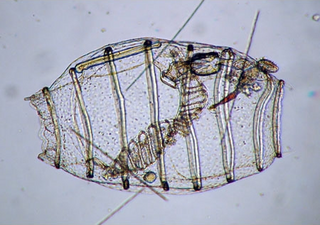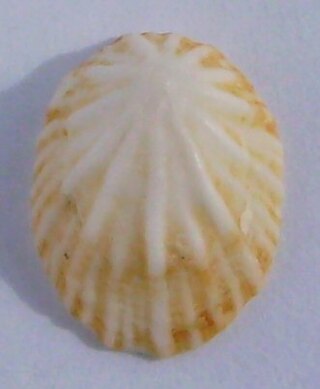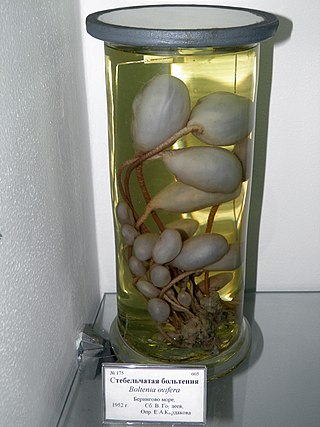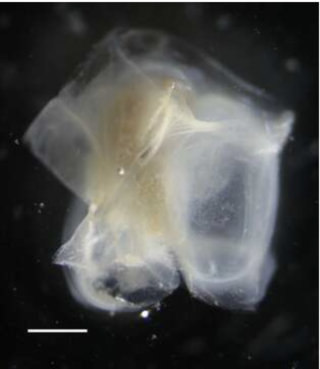
A tunicate is an exclusively marine invertebrate animal, a member of the subphylum Tunicata. This grouping is part of the Chordata, a phylum which includes all animals with dorsal nerve cords and notochords. The subphylum was at one time called Urochordata, and the term urochordates is still sometimes used for these animals. They are the only chordates that have lost their myomeric segmentation, with the possible exception of the seriation of the gill slits. However, doliolids still display segmentation of the muscle bands.

Thaliacea is a class of marine chordates within the subphylum Tunicata, comprising the salps, pyrosomes and doliolids. Unlike their benthic relatives the ascidians, from which they are believed to have emerged, thaliaceans are free-floating (pelagic) for their entire lifespan. The group includes species with complex life cycles, with both solitary and colonial forms.

The Doliolida are an order of small marine chordates of the subphylum Tunicata. They are in the class Thaliacea, which also includes the salps and pyrosomes. The doliolid body is small, typically 1–2 mm long, and barrel-shaped; it features two wide siphons, one at the front and the other at the back end, and eight or nine circular muscle strands reminiscent of barrel bands.

A salp or salpa is a barrel-shaped, planktonic tunicate in the family Salpidae. It moves by contracting, thereby pumping water through its gelatinous body; it is one of the most efficient examples of jet propulsion in the animal kingdom. The salp strains the pumped water through its internal feeding filters, feeding on phytoplankton.

Emarginula is a genus of small keyhole limpets, marine gastropod molluscs in the family Fissurellidae.

Patelloida is a genus of sea snails or true limpets, marine gastropod molluscs in the subfamily Lottiinae of the family Lottiidae, one of the families of true limpets.

Hemitoma is a genus of slit limpets, marine gastropod molluscs in the family Fissurellidae, the keyhole limpets and slit limpets.

Vermetus is a genus of sea snails, marine gastropod mollusks in the family Vermetidae, the worm snails or worm shells.

Doliolum is a genus of tunicates, the members of which move via jet propulsion. A detailed description can be found in the article, "On the anatomical structure of the trophozooid of Doliolum denticulatum."

Actinia is a genus of sea anemones in the family Actiniidae. Actinia display a rare form of heteromorphosis in which a cut inflicted on a specimen can develop into a second mouth.

Pyrosoma atlanticum is a pelagic species of marine colonial tunicate in the class Thaliacea found in temperate waters worldwide. The name of the genus comes from the Greek words pyros meaning 'fire' and soma meaning 'body', referring to the bright bioluminescence sometimes emitted. The specific epithet atlanticum refers to the Atlantic Ocean, from where the first specimen of the species was collected for scientific description; it was described in 1804 by François Péron, a French naturalist.
Dolioletta is a genus of tunicates in the family Doliolidae.
Dolioletta gegenbauri is a species of tunicate in the family Doliolidae. It is small, exists in various forms and is sometimes found in great abundance in the Atlantic and Pacific waters where it lives.
Dolioletta mirabilis is a species of tunicate in the family Doliolidae. It is small, exists in various forms and is sometimes found in great abundance in the Indo-Pacific waters where it lives.

Asterocarpa is a genus of ascidian tunicates in the family Styelidae.
Chorizocarpa is a genus of ascidian tunicates in the family Styelidae.

Distomus is a genus of ascidian tunicates in the family Styelidae.

Boltenia is a genus of ascidian tunicates in the family Pyuridae.

Abyla is a genus of colonial siphonophore in the subfamily Abylidae and the suborder Calycophorae. The genus contains three species and was established by Quoy and Gaimard in 1827.
Doliolina is a genus of tunicates belonging to the family Doliolidae.














